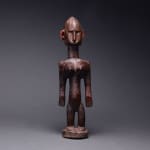Bambara Wooden Dyonyeni Sculpture of a Woman, 20th Century CE
Wood
height 41.9 cm
height 16 1/2 in
height 16 1/2 in
PF.6317
Further images
The African tribes, such as the Bambara, preferred to think of the spirits of their ancestors collectively rather than in terms of separate individuals. This is the result of the...
The African tribes, such as the Bambara, preferred to think of the spirits of their ancestors collectively rather than in terms of separate individuals. This is the result of the animism that underlies their religious beliefs. Such religious beliefs have been termed “animism” because they believed that a spirit exists in every living thing. Spirits dwell in the earth, in rivers and lakes, in the rain, in the sun and moon; still others demand to be appeased in order to promote fertility or cure disease. Their dwelling places may be given the shape of human figures, such as this glorious fertility sculpture depicting a standing woman. In this case, such spirits sometimes achieve enough of a stable identity to be viewed as rudimentary deities. This seems to be true of this gorgeous woman who conveys an air of authority and compassion befitting such a deity. Certainly, she represents the strongly revered fertility spirits, as indicated by her exaggerated voluptuous physique (her breasts actually seems to merge into her square shoulders and arms). The Bambara would dance and act out similar dramatic ceremonies to appease this deity in order to promote fertility. Nails driven into the wood serve as her eyes. Their reflective quality imparts the sense that she actually looks back at us. Her ears have been decorated with red threads tied together, suggestive of the earrings that real life Bambara women wear. A large majority of the surface of the work has been adorned with intricately designed carvings. These engraved strokes represent scarification patterns that are marks of both prestige and beauty. The energy and life force of fertility radiates from within this spectacular figure and the great emotional intensity of dances and ceremonies permeate the powerful appearance of this carving today.







